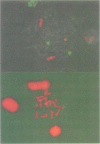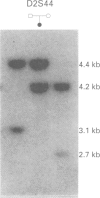Abstract
The t(11;22) (q23;q11) translocation is the most frequently identified familial reciprocal translocation in humans. In translocation carriers, 3:1 meiotic segregation with tertiary trisomy can occur resulting in abnormal progeny with the der(22) as the supernumary chromosome. Affected children have a distinct phenotype with multiple anomalies and severe mental retardation. We have identified a child with developmental delay and multiple anomalies consistent with the der(22) phenotype. Cytogenetic analysis showed an abnormal chromosome complement of 47,XX,+der(22)t(11;22)(q23; q11) in all 50 cells analysed. FISH analysis using chromosome 11 and 22 painting probes showed a pattern consistent with a reciprocal translocation of the distal bands 11q23 and 22q11 respectively. Parental karyotypes were normal. RFLP analysis of locus D22S43, which maps above the t(11;22) breakpoint, showed that the der(22) was paternal in origin and indicated that the normal chromosomes 22 were the probable result of maternal heterodisomy. RFLP analysis of locus D22S94, which maps below the t(11;22) breakpoint, also suggested that both normal chromosomes 22 of the child represented the two maternal homologues. Non-paternity was excluded through the analysis of 10 microsatellite markers distributed on 10 different chromosomes and three VNTRs on three different chromosomes. To the best of our knowledge, this is the first reported case of a patient with an abnormal karyotype resulting from a de novo translocation in the paternal germline with probable unbalanced adjacent 1 segregation and maternal non-disjunction of chromosome 22 in meiosis I.
Full text
PDF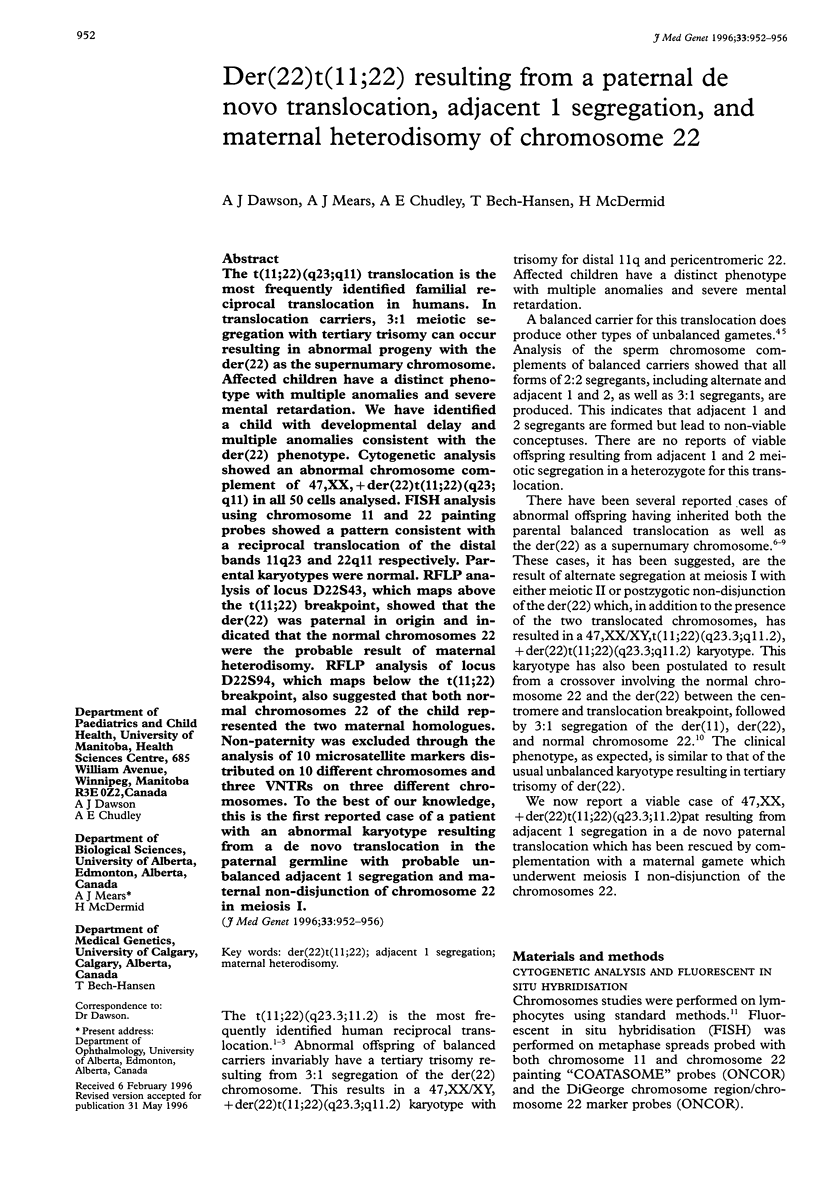

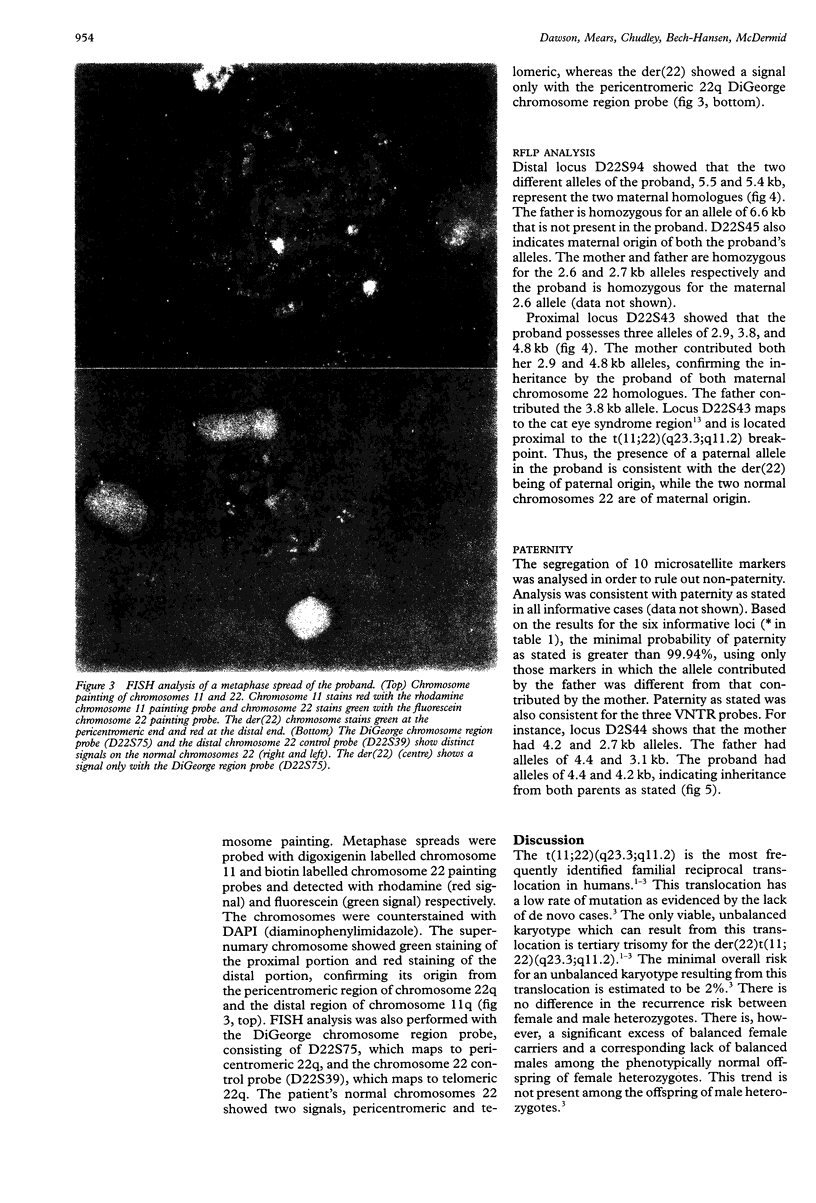
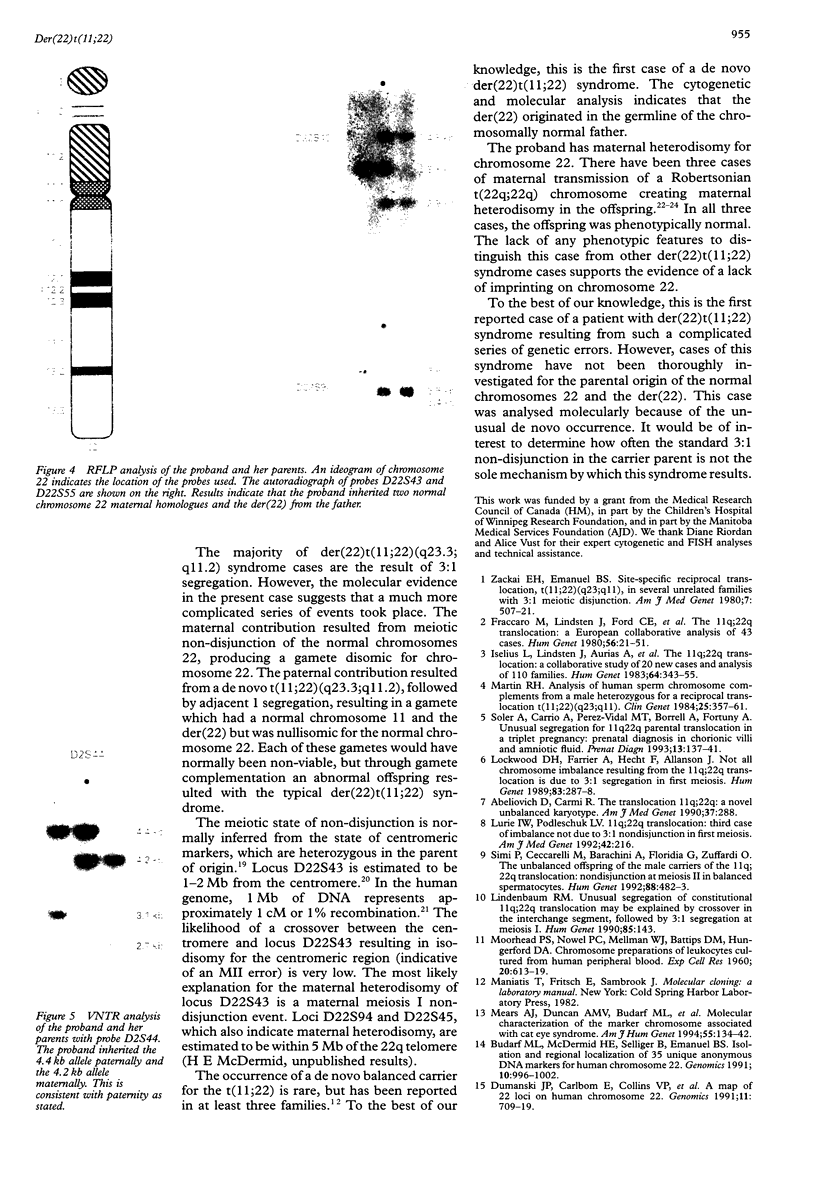
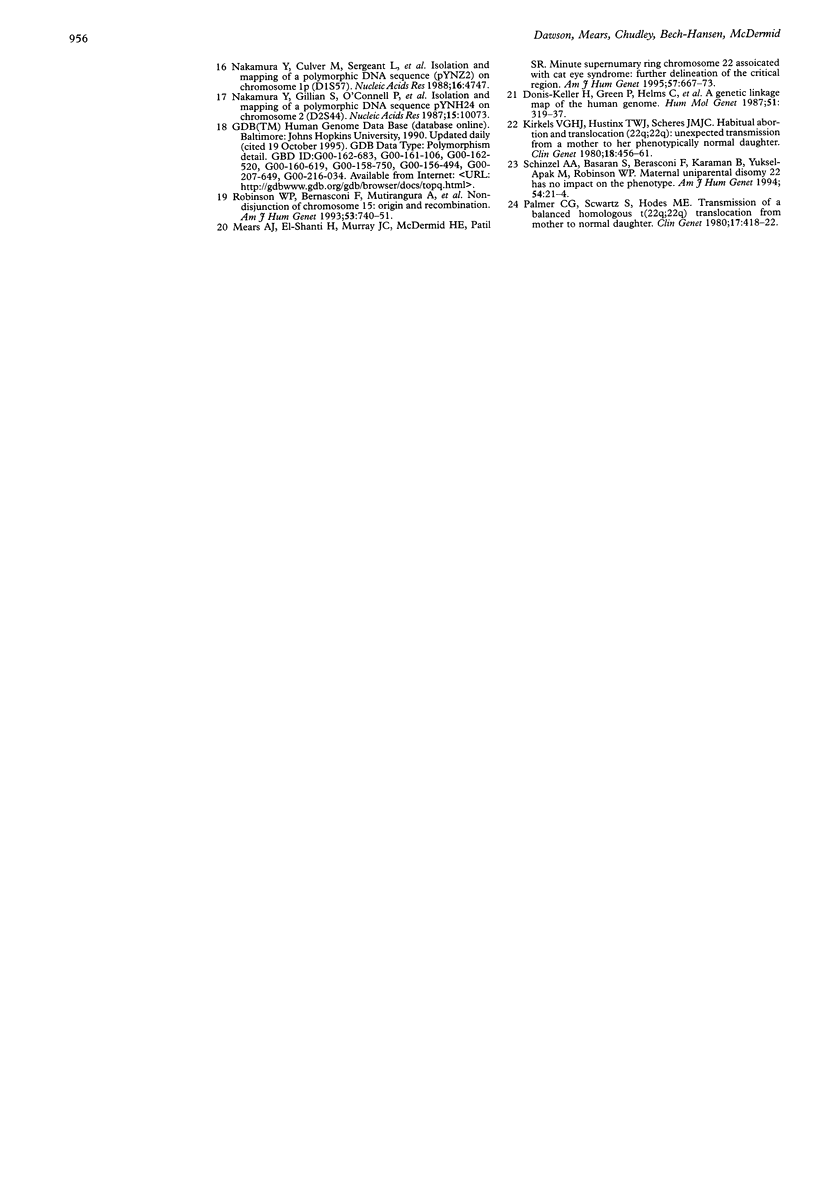
Images in this article
Selected References
These references are in PubMed. This may not be the complete list of references from this article.
- Abeliovich D., Carmi R. The translocation 11q;22q: a novel unbalanced karyotype. Am J Med Genet. 1990 Oct;37(2):288–288. doi: 10.1002/ajmg.1320370227. [DOI] [PubMed] [Google Scholar]
- Budarf M. L., McDermid H. E., Sellinger B., Emanuel B. S. Isolation and regional localization of 35 unique anonymous DNA markers for human chromosome 22. Genomics. 1991 Aug;10(4):996–1002. doi: 10.1016/0888-7543(91)90190-p. [DOI] [PubMed] [Google Scholar]
- Dumanski J. P., Carlbom E., Collins V. P., Nordenskjöld M., Emanuel B. S., Budarf M. L., McDermid H. E., Wolff R., O'Connell P., White R. A map of 22 loci on human chromosome 22. Genomics. 1991 Nov;11(3):709–719. doi: 10.1016/0888-7543(91)90079-t. [DOI] [PubMed] [Google Scholar]
- Fraccaro M., Lindsten J., Ford C. E., Iselius L. The 11q;22q translocation: a European collaborative analysis of 43 cases. Hum Genet. 1980;56(1):21–51. doi: 10.1007/BF00281567. [DOI] [PubMed] [Google Scholar]
- Iselius L., Lindsten J., Aurias A., Fraccaro M., Bastard C., Bottelli A. M., Bui T. H., Caufin D., Dalprà L., Delendi N. The 11q;22q translocation: a collaborative study of 20 new cases and analysis of 110 families. Hum Genet. 1983;64(4):343–355. doi: 10.1007/BF00292366. [DOI] [PubMed] [Google Scholar]
- Kirkels V. G., Hustinx T. W., Scheres J. M. Habitual abortion and translocation (22q;22q): unexpected transmission from a mother to her phenotypically normal daughter. Clin Genet. 1980 Dec;18(6):456–461. doi: 10.1111/j.1399-0004.1980.tb01794.x. [DOI] [PubMed] [Google Scholar]
- Lindenbaum R. H. Unusual segregation of constitutional 11q;22q translocation may be explained by crossover in interchange segment, followed by 3:1 segregation at meiosis I. Hum Genet. 1990 Jun;85(1):143–143. doi: 10.1007/BF00276346. [DOI] [PubMed] [Google Scholar]
- Lockwood D. H., Farrier A., Hecht F., Allanson J. Not all chromosome imbalance resulting from the 11q;22q translocation is due to 3:1 segregation in first meiosis. Hum Genet. 1989 Oct;83(3):287–288. doi: 10.1007/BF00285174. [DOI] [PubMed] [Google Scholar]
- Lurie I. W., Podleschuk L. V. 11q;22q translocation: third case of imbalance not due to 3:1 nondisjunction in first meiosis. Am J Med Genet. 1992 Jan 15;42(2):216–216. doi: 10.1002/ajmg.1320420218. [DOI] [PubMed] [Google Scholar]
- MOORHEAD P. S., NOWELL P. C., MELLMAN W. J., BATTIPS D. M., HUNGERFORD D. A. Chromosome preparations of leukocytes cultured from human peripheral blood. Exp Cell Res. 1960 Sep;20:613–616. doi: 10.1016/0014-4827(60)90138-5. [DOI] [PubMed] [Google Scholar]
- Martin R. H. Analysis of human sperm chromosome complements from a male heterozygous for a reciprocal translocation t(11;22)(q23;q11). Clin Genet. 1984 Apr;25(4):357–361. doi: 10.1111/j.1399-0004.1984.tb02004.x. [DOI] [PubMed] [Google Scholar]
- Mears A. J., Duncan A. M., Budarf M. L., Emanuel B. S., Sellinger B., Siegel-Bartelt J., Greenberg C. R., McDermid H. E. Molecular characterization of the marker chromosome associated with cat eye syndrome. Am J Hum Genet. 1994 Jul;55(1):134–142. [PMC free article] [PubMed] [Google Scholar]
- Mears A. J., el-Shanti H., Murray J. C., McDermid H. E., Patil S. R. Minute supernumerary ring chromosome 22 associated with cat eye syndrome: further delineation of the critical region. Am J Hum Genet. 1995 Sep;57(3):667–673. [PMC free article] [PubMed] [Google Scholar]
- Nakamura Y., Culver M., Sergeant L., Leppert M., O'Connell P., Lathrop G. M., Lalouel J. M., White R. Isolation and mapping of a polymorphic DNA sequence (pYNZ2) on chromosome 1p [D1S57]. Nucleic Acids Res. 1988 May 25;16(10):4747–4747. doi: 10.1093/nar/16.10.4747. [DOI] [PMC free article] [PubMed] [Google Scholar]
- Nakamura Y., Gillilan S., O'Connell P., Leppert M., Lathrop G. M., Lalouel J. M., White R. Isolation and mapping of a polymorphic DNA sequence pYNH24 on chromosome 2 (D2S44). Nucleic Acids Res. 1987 Dec 10;15(23):10073–10073. doi: 10.1093/nar/15.23.10073. [DOI] [PMC free article] [PubMed] [Google Scholar]
- Palmer C. G., Schwartz S., Hodes M. E. Transmission of a balanced homologous t(22q;22q) translocation from mother to normal daughter. Clin Genet. 1980 Jun;17(6):418–422. doi: 10.1111/j.1399-0004.1980.tb00173.x. [DOI] [PubMed] [Google Scholar]
- Robinson W. P., Bernasconi F., Mutirangura A., Ledbetter D. H., Langlois S., Malcolm S., Morris M. A., Schinzel A. A. Nondisjunction of chromosome 15: origin and recombination. Am J Hum Genet. 1993 Sep;53(3):740–751. [PMC free article] [PubMed] [Google Scholar]
- Simi P., Ceccarelli M., Barachini A., Floridia G., Zuffardi O. The unbalanced offspring of the male carriers of the 11q;22q translocation: nondisjunction at meiosis II in a balanced spermatocyte. Hum Genet. 1992 Feb;88(4):482–483. doi: 10.1007/BF00215688. [DOI] [PubMed] [Google Scholar]
- Soler A., Carrio A., Perez-Vidal M. T., Borrell A., Fortuny A. Unusual segregation for 11q;22q parental translocation in a triplet pregnancy: prenatal diagnosis in chorionic villi and amniotic fluid. Prenat Diagn. 1993 Feb;13(2):137–141. doi: 10.1002/pd.1970130209. [DOI] [PubMed] [Google Scholar]
- Zackai E. H., Emanuel B. S. Site-specific reciprocal translocation, t(11;22) (q23;q11), in several unrelated families with 3:1 meiotic disjunction. Am J Med Genet. 1980;7(4):507–521. doi: 10.1002/ajmg.1320070412. [DOI] [PubMed] [Google Scholar]





